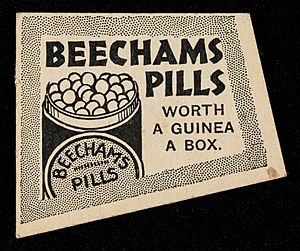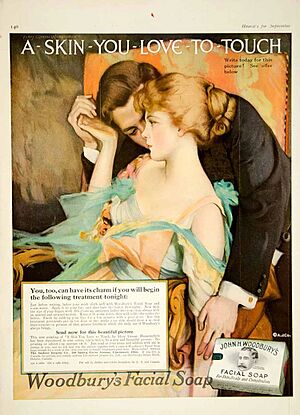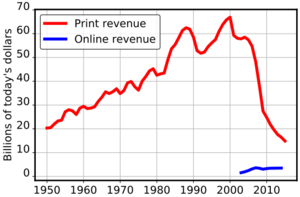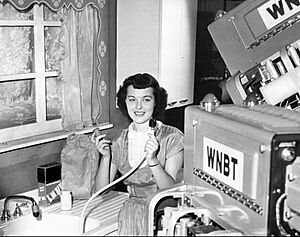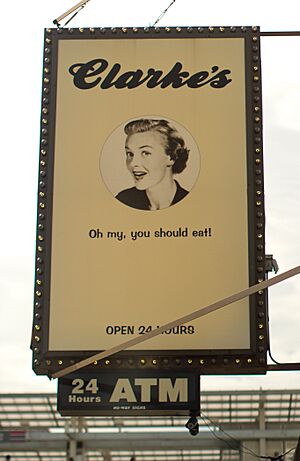Advertising facts for kids
Advertising is how companies and organizations get people to notice their products or services. It's all about showing what a product can do, its benefits, and why it's useful to customers. Most often, advertising helps sell specific items or services, but it also has many other uses, like promoting ideas or causes.
Commercial ads often try to make people buy more by creating a "brand". This means linking a product's name or image with certain good qualities in people's minds. Some ads, called direct-response advertising, want you to buy something right away. Not just businesses advertise; political groups, interest groups, religious organizations, and government offices also use advertising. Non-profit groups might use free ways to share their message, like public service announcements. Advertising can also show employees and shareholders that a company is doing well.
In the 1800s, soap companies were among the first to use big advertising campaigns. A person named Thomas J. Barratt worked for Pears soap and became the first "brand manager." He created slogans and images. He even hired a famous actress, Lillie Langtry, to be the face of Pears, making her the first celebrity to promote a product. Modern advertising really took off with new methods used for tobacco advertising in the 1920s, especially through the work of Edward Bernays, who is often called the founder of modern advertising.
In 2015, about $529.43 billion was spent on advertising worldwide. By 2017, much of this money went to TV (40.4%) and digital ads (33.3%). Other media like newspapers, magazines, outdoor ads, and radio also received significant portions. The biggest advertising groups globally include Omnicom, WPP, Publicis, Interpublic, and Dentsu.
Contents
A Look Back: How Advertising Began


Ancient Egyptians used papyrus for sales messages and posters on walls. People have found commercial and political campaign ads in the old cities of Pompeii and Arabia. Ads for lost and found items on papyrus were common in ancient Greece and ancient Rome. Painting ads on walls or rocks is a very old form of advertising that you can still see today in parts of Asia, Africa, and South America. This tradition goes back to Indian rock art from 4000 BC.
In ancient China, the first known advertising was spoken. People played bamboo flutes to sell candy, as recorded in the Classic of Poetry (11th to 7th centuries BC). Ads often appeared as fancy signs or inked papers. A copper printing plate from the Song dynasty shows a rabbit logo with "Jinan Liu's Fine Needle Shop" and a message about making quality needles. This is thought to be the world's oldest printed advertisement.
In Europe, as towns grew in the Middle Ages, most people couldn't read. So, instead of words, shops used pictures to show what they sold. A shoemaker might have a boot sign, a tailor a suit, or a blacksmith a horseshoe. Fruits and vegetables were sold from carts in city squares, and sellers used town criers to announce where they were. The first collection of these street announcements was in a 13th-century poem called "Les Crieries de Paris."
Ads in Newspapers: 18th and 19th Centuries

In the 1700s, ads began appearing in weekly newspapers in England. These early print ads mostly promoted books, newspapers (which became cheaper to print), and medicines. However, false advertising and misleading "quack" ads became a problem. This led to rules about what ads could say.
In the United States, newspapers grew quickly in the early 1800s, partly because of advertising. By 1822, the U.S. had more newspaper readers than any other country. About half of these newspapers' content was advertising, usually local. Many daily newspapers in the 1810s even had "advertiser" in their name.
In August 1859, a British company called Beechams created a slogan for its pills: "Beechams Pills: Worth a guinea a box." This is considered the world's first advertising slogan. Beechams ads appeared in newspapers worldwide, helping the company become a global brand.
In June 1836, the French newspaper La Presse was the first to include paid ads. This allowed it to lower its price, reach more readers, and make more profit. Other newspapers soon copied this idea. Around 1840, Volney B. Palmer started what would become the modern advertising agency in Philadelphia. He bought large amounts of newspaper space at a discount and then resold it to advertisers at higher prices. The companies still made their own ads. This changed in 1869 when N.W. Ayer & Son, the first full-service advertising agency, opened in Philadelphia. Ayer & Son planned, created, and ran entire ad campaigns for clients. By 1900, advertising agencies were central to creative planning, and advertising became a recognized profession.
Modern Advertising Takes Shape
The late 1800s and early 1900s saw the rise of modern advertising. This was fueled by factories making more goods and more people buying them. Ad agencies started using clever words and ideas to persuade people. Thomas J. Barratt of London is often called "the father of modern advertising." Working for Pears soap, he created successful campaigns with catchy slogans and images. One famous slogan was, "Good morning. Have you used Pears' soap?" In 1882, Barratt hired actress Lillie Langtry to be the face of Pears, making her the first celebrity to endorse a product.

Barratt became the company's brand manager in 1865, a role listed as the first of its kind by the Guinness Book of Records. He introduced many key ideas for successful advertising. He always stressed having a strong and unique brand image for Pears and making sure the product was widely available. He also understood that tastes change, and advertisers must change with them.
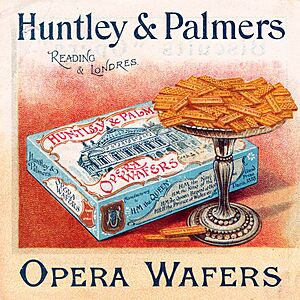
The Industrial Revolution in Britain led to more advertising. By the mid-1800s, biscuits and chocolate became popular for everyone. British biscuit makers were among the first to use branding to make their products stand out. Huntley & Palmers biscuits, one of the world's first global brands, were sold in 172 countries by 1900. Their ads showed their worldwide reach.

Advertising in the 20th Century

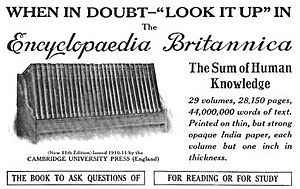
After a period of huge industrial growth, advertising in the United States increased a lot. In 1919, it made up 2.5% of the country's total economic output (GDP). This percentage stayed around 2.2% until at least 2007.
Factories could not sell all their new products without people buying more. This led to "mass marketing," which aimed to influence many people's buying habits. In the 1910s and 1920s, advertisers in the U.S. started to believe they could target human instincts and turn them into a desire to buy things. Edward Bernays, a nephew of Sigmund Freud, became known for this idea and is sometimes called the founder of modern advertising. He believed that understanding people's hidden motivations was more effective than just appealing to their logical minds.
In the 1920s, the American government, under Secretary of Commerce Herbert Hoover, supported advertising. Hoover even gave a speech in 1925 called "Advertising Is a Vital Force in Our National Life." In 1929, a government official said, "Advertising is the key to world prosperity." This showed how closely businesses and the government worked together then.
Companies selling certain products, like tobacco, became big advertisers to sell packaged cigarettes. They were pioneers in using new advertising methods, hiring Bernays to create positive feelings about smoking.
Advertising also helped new workers adapt to a shared "modern" lifestyle, encouraging them to change traditional habits. The American Association of Foreign Language Newspapers (AAFLN) was important for influencing immigrant workers. It was mainly an advertising agency but also controlled much of the immigrant press.
Around 1900, advertising was one of the few career choices for women. Since women did most of the household shopping, advertisers realized how valuable women's ideas were in creating ads. In fact, one of the first American ads to use a subtle romantic appeal was created by a woman for a soap product. The ad featured a couple with the message "A skin you love to touch."
In the 1920s, psychologists Walter D. Scott and John B. Watson applied ideas from psychology to advertising. Scott suggested that people are more easily influenced by suggestions than by pure logic. He showed this by using direct commands to consumers in ads.
Radio Advertising from the 1920s

In the early 1920s, the first radio stations started. Retailers and companies quickly saw that radio could reach people in their homes. They soon used advertising techniques like slogans, mascots, and jingles on radio in the 1920s and early television in the 1930s.
Mass media allowed companies to advertise directly to consumers, bypassing stores. This made companies focus on their brand and understand what customers wanted and needed. Early radio shows were sponsored by soap makers, which is why they became known as soap operas. Soon, radio stations realized they could sell small blocks of "air-time" to many businesses. By the 1930s, these "advertising spots" were sold by sales representatives, starting an era of national radio advertising.
By the 1940s, companies understood that people formed personal connections with brands. Advertisers began using research to understand why people bought things. Strong campaigns for companies like Chrysler and Exxon/Esso, using ideas from psychology, led to some of the most memorable ads of the 20th century.
Television Ads in the 1950s
In the early 1950s, the DuMont Television Network started selling ad time to many different sponsors. Before this, shows often had only one sponsor. DuMont found it hard to get single sponsors for all its programs, so it sold smaller ad blocks to several businesses. This became the standard for TV advertising in the U.S.
Cable TV and the Internet: From the 1980s Onwards
The late 1980s and early 1990s brought cable television, especially MTV. MTV introduced a new kind of advertising: music videos, where people watched for the ad message. As cable and satellite TV grew, special channels appeared, including channels completely devoted to advertising, like QVC and Home Shopping Network.
With the rise of the ad server, online advertising grew, helping the "dot-com" boom of the 1990s. Many companies relied only on ad revenue, offering everything from coupons to free Internet. Around 2000, some websites, like the search engine Google, changed online advertising by showing personalized ads based on what people looked at online. This led to more interactive advertising. Online advertising created new ways to target specific groups and engage with them, with platforms like Google and Facebook leading the way. This change made digital advertising a very powerful force.
The amount of money spent on advertising compared to a country's total economic output (GDP) has stayed fairly similar since 1925, even with big changes in media. In 1925, the main ads in America were in newspapers, magazines, on streetcars, and on outdoor posters. Advertising spending was about 2.9% of GDP. By 1998, TV and radio were major ad media. By 2017, online spending had surpassed broadcast. Still, advertising spending as a share of GDP was slightly lower, around 2.4%.
Guerrilla marketing uses unusual methods, like staged events in public, giving away products covered with brand messages, or interactive ads where viewers can join in. This type of advertising is surprising and can make people interested in a product or idea. This shows a trend towards interactive and "embedded" ads, like product placement in movies, or campaigns using social network services like Facebook or Twitter.
The way advertising businesses make money has also changed. In media for equity, advertising is given to new companies in exchange for a share of their ownership. If the company grows and is sold, the media companies get money for their shares.
People who register domain names (website addresses) as an investment sometimes "park" them. They allow advertising companies to place ads on these sites for payments each time someone clicks. These ads often come from search engines like Google or Yahoo.
Where Do We See Ads? Different Types of Media
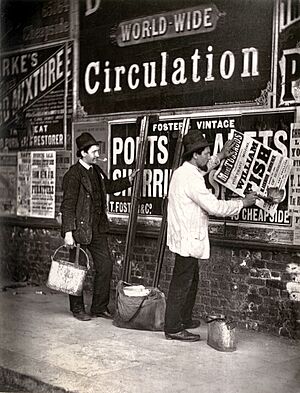
Almost anything can be used for advertising. Commercial ads can be found on wall paintings, billboards, street furniture, flyers, radio, cinema, TV, web banners, mobile phone screens, shopping carts, pop-up ads, skywriting, bus stop benches, human billboards, magazines, newspapers, and even on the sides of buses or attached to airplanes. If a sponsor pays to deliver a message through any medium, it's advertising.
| Medium | 2015 | 2017 |
|---|---|---|
| Television advertisement | 37.7% | 34.8% |
| Desktop online advertising | 19.9% | 18.2% |
| Mobile advertising | 9.2% | 18.4% |
| Newspaper | 12.8% | 10.1% |
| Magazines | 6.5% | 5.3% |
| Outdoor advertising | 6.8% | 6.6% |
| Radio advertisement | 6.5% | 5.9% |
| Cinema | 0.6% | 0.7% |
- Television
- TV advertising can be very expensive, especially during popular shows or events. For example, the Super Bowl football game in the U.S. is famous for its high-cost ads. In 2014, a 30-second ad during the Super Bowl cost $4 million. Sometimes, virtual ads are added to TV shows using computer graphics, like replacing a billboard in the background with a different ad. An infomercial is a long TV commercial, usually five minutes or more. It aims to make you buy something right away by showing and explaining a product, often with customer stories.
- Radio
- Radio ads are broadcast through radio waves. Companies buy airtime from stations to play their commercials. Radio ads rely only on sound, which some see as an advantage. Radio is still a popular medium, with millions of listeners each week.
- Online
- Online advertising uses the Internet to deliver marketing messages. These ads are shown by an ad server. Examples include ads on search engine results pages, banner ads, pay per click text ads, and e-mail marketing. A newer type is Native Ads, which blend into a website's content, like a news feed. Some people find these less annoying, but others think they can be misleading.
- Domain names
- Advertising on domain names often happens through pay-per-click search engines. However, advertisers also lease space directly on domain names that describe their products. When you type a website address directly into your browser, it's called "direct navigation." Many people still do this, for example, typing "flowers.com." This can lead to targeted sales.
- Product placements
- This is when a product or brand appears within movies, TV shows, or other media. For instance, in the movie Minority Report, the main character uses a phone with the Nokia logo. In I, Robot, the character played by Will Smith talks about his Converse shoes. Car brands like Audi and Mercedes-Benz have also appeared in futuristic films. Recent James Bond movies feature Omega Watches, Ford, and Aston Martin cars.
- Print advertising includes ads in newspapers, magazines, or trade journals. This can range from ads in big national magazines to small local newspapers. One type is classified advertising, which are small, text-only ads often paid by the word. Another is a display ad, which is usually larger and includes pictures or designs, found in the main sections of a newspaper.
- Outdoor

Billboards (also called hoardings) are large signs in public places that show ads to people walking or driving by. They are often on main roads or in busy spots like train stations or shopping malls. Street advertising also includes things like Reverse Graffiti (cleaning ads into dirty surfaces), air dancers, and 3D pavement art. Mobile billboards are ads on vehicles or digital screens, often driven along specific routes. These can be used for special events or to reach certain areas.
- Point-of-sale
- In-store advertising is any ad placed inside a retail store. This includes putting products in easy-to-see spots, like at eye level or near checkout counters. It also includes eye-catching displays for specific products, or ads on shopping carts and in-store video screens.
- Novelties
- Advertising printed on small items like coffee mugs, T-shirts, pens, or bags is called novelty advertising. These items can be given away by the advertiser or as part of a promotion, like ads on fast food containers.
- Celebrity endorsements
- This is when a famous person promotes a product or brand. Advertisers use a celebrity's fame and popularity to get attention for their products. Celebrities often appear in TV or print ads.
- Aerial
- This involves using aircraft, balloons, or airships to create or display ads. Skywriting is a well-known example.
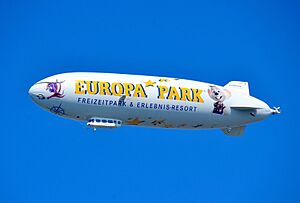
New Ways to Reach People
Newer advertising methods, called advanced advertising, use lots of data and precise tools to target specific groups of people. This also helps companies selling ad space to see if their ads led to customer purchases.
More and more, new media are becoming more popular than traditional ones like TV and radio. This is because people use the Internet for news and music, and devices like digital video recorders (DVRs) let them skip commercials.
Online advertising started with unwanted bulk emails, known as "e-mail spam". Spam has been a problem since 1978. As new online communication methods appeared, advertising followed. The first banner ad on the World Wide Web appeared in 1994. The cost of online ad space depends on how relevant the website content is and how many visitors it gets.
Online display ads quickly create awareness. Unlike search ads, which require someone to already know what they need, display ads can introduce something new. They also work well for direct sales, linking to a page where you can buy the product.
When mobile phones became a mass medium in 1998, mobile advertising soon followed, starting in Finland in 2000. By 2007, mobile advertising was worth $2 billion. More advanced mobile ads include banners, coupons, picture and video messages, and games that are also ads. A special feature is the 2D barcode, which lets you use your phone camera to quickly access web content without typing.
Some companies have even suggested putting messages or logos on rockets or the International Space Station.
Sometimes, advertising is unpaid, like personal recommendations or word-of-mouth. This can also happen when a brand name becomes so common that it's used for any similar product (like "Kleenex" for tissue). However, some companies don't like this because it can make their brand name lose its special legal protection.
A new idea called "ARvertising" uses augmented reality technology for ads.
There's also debate about whether subliminal advertising (hidden messages) works, and about how widespread mass messages (propaganda) are.
Niche Marketing
Another important trend is niche marketing, which uses targeted ads for specific groups. Thanks to the Internet, advertisers can now reach smaller but very well-defined audiences. In the past, ads tried to reach the largest possible audience. Now, with tracking and customer profiles, ads can be more relevant to viewers and more effective for companies. For example, Google AdSense shows ads based on the content of a website or even keywords in emails.
Crowdsourcing Ads
Crowdsourcing has led to "user-generated" advertisements. These ads are created by regular people, often through contests sponsored by brands. For the 2007 Super Bowl, PepsiCo's Frito-Lays held a "Crash the Super Bowl" contest, letting people create their own Doritos commercials. These user-generated ads were very popular. Another example is Jones Soda, which lets consumers design their bottle labels.
This trend has created online platforms that host ad competitions for companies. While crowdsourcing is popular, its long-term impact on the advertising industry is still being discussed.
Global Advertising
Advertising has grown through several stages: local, export, international, multi-national, and global. For companies advertising worldwide, they need to balance building a brand with a consistent message, saving money on creative work, making ads effective locally, and quickly putting ads into action.
Research is key to knowing if an ad will work in different countries. Understanding what parts of an ad are successful helps companies save money. Once a good idea is found, it can be used in other markets.
Foreign Public Messaging
Sometimes, foreign governments, especially those that own businesses, promote their interests by advertising their products or services. People might not realize these ads also carry messages about the country itself. A good example is ads for international travel. While these ads aim to attract tourists, they can also try to create good feelings about a country. Many foreign airlines and travel services are owned by their governments, like Emirates airline (Dubai) or Singapore Airlines (Singapore). By showing their destinations and services in a positive light, countries can improve how people abroad view them.
New Technology and Advertising
New technology, like digital video recorders (DVRs) such as TiVo, lets people record shows and fast-forward through commercials. Also, with more TV shows available as pre-recorded sets, fewer people watch them live with ads.
To deal with this, advertisers use different strategies. Many place products directly into TV shows, like on Survivor. Other ideas include ads on smartphones or tablets during a show, or creating mobile apps for TV programs. Some brands also sponsor social media discussions around TV shows.
The new technology of drone displays has also been used for advertising.
Learning About Advertising
In recent years, there have been efforts to help people understand media better, especially advertising. These programs aim to empower citizens to think critically about ad campaigns.
Studying advertising has become popular, with many colleges offering degrees in the subject. Interest in advertising often grows because it's closely linked to cultural and technological changes, like the rise of online social media. A unique way to learn about advertising is through student-run agencies, where students create real campaigns for companies.
Why Companies Advertise
Advertising is important for sharing the right message with current and future customers. Its main goals are to inform people about a product, convince them that a company's products or services are the best, improve the company's image, show new uses for existing products, announce new products, support salespeople, attract new customers, and keep existing ones.
Sales Promotions and Brand Loyalty
Sales promotions are another way to advertise. They have two purposes: to learn about customers and to boost sales. Sales promotions include contests, games, giveaways, samples, coupons, loyalty programs, and discounts. The main goal is to encourage potential customers to take action and buy something.
Thinking Critically About Ads
While advertising helps the economy, it also has some downsides. Unwanted emails and other forms of spam have become a big annoyance for users and a cost for Internet providers. Advertising is increasingly appearing in public places, like schools, which some critics worry about, especially ads targeting children. This can sometimes lead to negative reactions from the public. Surveys often show low approval for the advertising industry. A 2021 study found that for many brands, advertising did not lead to a positive return on investment. Unwanted ads are sometimes called "attention theft."
One of the biggest concerns today is the large amount of advertising for foods high in sugar, fat, and salt, especially those aimed at children. Critics say these ads take advantage of children and are not balanced with enough information about healthy eating. Children might not fully understand that they are being sold something, making them more easily influenced. For example, Michelle Obama has asked food companies to limit advertising unhealthy foods to children or to advertise healthier options. Other criticisms include how ads can change society and the use of misleading ads by companies, especially in the cosmetic and health industries. Political ads are also often criticized for misinformation, ethical issues, and political bias.
Rules and Guidelines for Advertising
There are growing efforts to protect the public by regulating what ads can say and how they influence people. For example, many countries have rules for advertising alcohol, tobacco, or gambling. There are also bans on advertising to children in parts of Europe. Ad rules often focus on whether claims are true, especially for food and healthcare products.
In some countries, the advertising industry relies more on self-regulation than on laws. Advertisers and media companies agree on a code of standards they try to follow. The goal is to make sure ads are "legal, decent, honest, and truthful." Some self-regulatory groups are funded by the industry but remain independent, like the Advertising Standards Authority in the UK.
In the UK, most outdoor advertising, like billboards, is regulated by planning laws. Putting up an ad without permission is a crime. In the U.S., some communities see billboards as a visual problem, leading to laws like the Highway Beautification Act in the 1960s. Cities like São Paulo have even banned billboards completely.
Some governments restrict the languages used in ads. For example, in France, advertisers sometimes print English words in bold with small French translations to get around a law limiting English.
The advertising of prices is another area governments watch. In the U.S., businesses often mention taxes only later in a purchase. In Canada and New Zealand, taxes can be listed separately but must be shown upfront. In most other countries, the advertised price must include all taxes so customers know the full cost right away.
How Advertising Works: Some Ideas
Advertising aims to guide a buyer through several steps when making a purchase:
- Becoming aware of a product.
- Learning about it.
- Liking it.
- Preferring it over others.
- Being convinced to buy it.
- Actually making the purchase.
The "marketing mix" is a concept with four basic elements, often called the "four Ps":
- Product is the actual item or service.
- Price is how its value is decided.
- Place is how the product gets to the customer (like through stores or online).
- Promotion is how the target audience is reached and convinced to buy. This includes advertising, sales promotions, and public relations.
Advertising research helps make ads more effective. This includes testing ads before they run (pre-testing) and after (post-testing). Pre-testing uses methods like focus groups to understand how different people react to messages and visuals. Post-testing looks at how ads change people's awareness or attitudes. With digital ads, companies can constantly test ads using real-time data.
Semiotics is the study of signs and how they are understood. Advertising uses many hidden signs and meanings in brand names, logos, package designs, and ads. Semiotics helps us understand the messages in ads. Logos and ads can be understood on two levels: the surface level (images, words, colors) and the deeper, hidden meaning. For example, the white color of Apple's headphones came to mean that the music device was an iPod.
Alternatives to Advertising
Other ways for companies to make money include donations, paid subscriptions, small payments for digital items (microtransactions), and selling data. Websites and apps are "ad-free" if they don't use ads for revenue. For example, the online encyclopedia Wikipedia offers free content by getting money from charitable donations.
Important People in Advertising
- Late 1700s – Benjamin Franklin (1706–1790) – known as the "father of advertising in America."
- Late 1800s – Thomas J. Barratt (1841–1914) – called "the father of modern advertising."
- Early 1900s – Albert Lasker (1880–1952) – also called the "father of modern advertising"; he described advertising as "salesmanship in print, driven by a reason why."
See also
 In Spanish: Publicidad para niños
In Spanish: Publicidad para niños
- Advertisements in schools
- Advertorial
- Ambush marketing
- Annoyance factor
- Bibliography of advertising
- Branded content
- Commercial speech
- Comparative advertising
- Conquesting
- Copywriting
- Demo mode
- Direct-to-consumer advertising
- False advertising
- Family in advertising
- Graphic design
- Gross rating point
- Guerrilla marketing
- History of Advertising Trust
- Informative advertising
- Integrated marketing communications
- List of advertising awards
- Local advertising
- Market overhang
- Media planning
- Meta-advertising
- Mobile marketing
- Performance-based advertising
- Promotional mix
- Senior media creative
- Shock advertising
- Surrogate advertising
- Viral marketing
- World Federation of Advertisers



